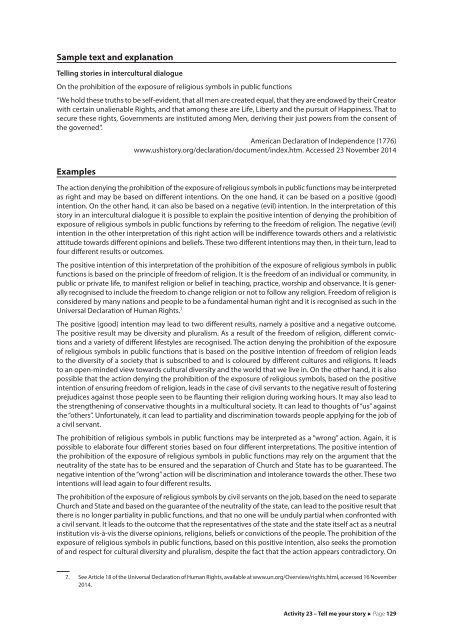TASKs for democracy
4NYw4W
4NYw4W
Create successful ePaper yourself
Turn your PDF publications into a flip-book with our unique Google optimized e-Paper software.
Sample text and explanation<br />
Telling stories in intercultural dialogue<br />
On the prohibition of the exposure of religious symbols in public functions<br />
“We hold these truths to be self-evident, that all men are created equal, that they are endowed by their Creator<br />
with certain unalienable Rights, and that among these are Life, Liberty and the pursuit of Happiness. That to<br />
secure these rights, Governments are instituted among Men, deriving their just powers from the consent of<br />
the governed”.<br />
Examples<br />
American Declaration of Independence (1776)<br />
www.ushistory.org/declaration/document/index.htm. Accessed 23 November 2014<br />
The action denying the prohibition of the exposure of religious symbols in public functions may be interpreted<br />
as right and may be based on different intentions. On the one hand, it can be based on a positive (good)<br />
intention. On the other hand, it can also be based on a negative (evil) intention. In the interpretation of this<br />
story in an intercultural dialogue it is possible to explain the positive intention of denying the prohibition of<br />
exposure of religious symbols in public functions by referring to the freedom of religion. The negative (evil)<br />
intention in the other interpretation of this right action will be indifference towards others and a relativistic<br />
attitude towards different opinions and beliefs. These two different intentions may then, in their turn, lead to<br />
four different results or outcomes.<br />
The positive intention of this interpretation of the prohibition of the exposure of religious symbols in public<br />
functions is based on the principle of freedom of religion. It is the freedom of an individual or community, in<br />
public or private life, to manifest religion or belief in teaching, practice, worship and observance. It is generally<br />
recognised to include the freedom to change religion or not to follow any religion. Freedom of religion is<br />
considered by many nations and people to be a fundamental human right and it is recognised as such in the<br />
Universal Declaration of Human Rights. 7<br />
The positive (good) intention may lead to two different results, namely a positive and a negative outcome.<br />
The positive result may be diversity and pluralism. As a result of the freedom of religion, different convictions<br />
and a variety of different lifestyles are recognised. The action denying the prohibition of the exposure<br />
of religious symbols in public functions that is based on the positive intention of freedom of religion leads<br />
to the diversity of a society that is subscribed to and is coloured by different cultures and religions. It leads<br />
to an open-minded view towards cultural diversity and the world that we live in. On the other hand, it is also<br />
possible that the action denying the prohibition of the exposure of religious symbols, based on the positive<br />
intention of ensuring freedom of religion, leads in the case of civil servants to the negative result of fostering<br />
prejudices against those people seen to be flaunting their religion during working hours. It may also lead to<br />
the strengthening of conservative thoughts in a multicultural society. It can lead to thoughts of “us” against<br />
the “others”. Un<strong>for</strong>tunately, it can lead to partiality and discrimination towards people applying <strong>for</strong> the job of<br />
a civil servant.<br />
The prohibition of religious symbols in public functions may be interpreted as a “wrong” action. Again, it is<br />
possible to elaborate four different stories based on four different interpretations. The positive intention of<br />
the prohibition of the exposure of religious symbols in public functions may rely on the argument that the<br />
neutrality of the state has to be ensured and the separation of Church and State has to be guaranteed. The<br />
negative intention of the “wrong” action will be discrimination and intolerance towards the other. These two<br />
intentions will lead again to four different results.<br />
The prohibition of the exposure of religious symbols by civil servants on the job, based on the need to separate<br />
Church and State and based on the guarantee of the neutrality of the state, can lead to the positive result that<br />
there is no longer partiality in public functions, and that no one will be unduly partial when confronted with<br />
a civil servant. It leads to the outcome that the representatives of the state and the state itself act as a neutral<br />
institution vis-à-vis the diverse opinions, religions, beliefs or convictions of the people. The prohibition of the<br />
exposure of religious symbols in public functions, based on this positive intention, also seeks the promotion<br />
of and respect <strong>for</strong> cultural diversity and pluralism, despite the fact that the action appears contradictory. On<br />
7. See Article 18 of the Universal Declaration of Human Rights, available at www.un.org/Overview/rights.html, accessed 16 November<br />
2014.<br />
Activity 23 – Tell me your story Page 129


